
Epacris is a genus of about forty species of flowering plants in the family Ericaceae. It was formerly treated in a closely related but separate family Epacridaceae, but the various genera within Epacridaceae including Epacris have been revised in their relationships to each other and brought under the common umbrella of the Ericaceae. The genus Epacris is native to eastern and southeastern Australia, New Caledonia and New Zealand. The species are known as heaths or Australian heaths.
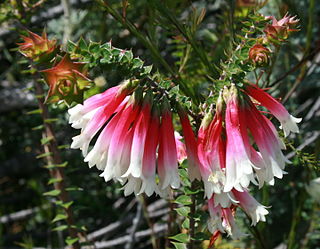
Epacris longiflora, commonly known as fuchsia heath or cigarette flower, is a plant in the family Ericaceae and is endemic to eastern Australia. It is an erect or spreading shrub with egg-shaped, pointed leaves and red tube-shaped flowers which give the plant its name longiflora and are usually present throughout the year. Its native range extends from the central coast of New South Wales to southern Queensland.
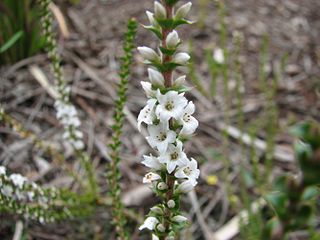
Epacris gunnii is a species of flowering plant in the family Ericaceae and is endemic to south-eastern Australia. It is an erect shrub with hairy branchlets, concave, sharply-pointed, broadly egg-shaped leaves, and tube-shaped, white flowers arranged along the stems.

Pomaderris ferruginea, commonly known as rusty pomaderris, is a species of flowering plant in the family Rhamnaceae and is endemic to south-eastern continental Australia. It is a shrub with rusty-hairy stems, egg-shaped leaves, and clusters of cream-coloured, whitish or yellow flowers.
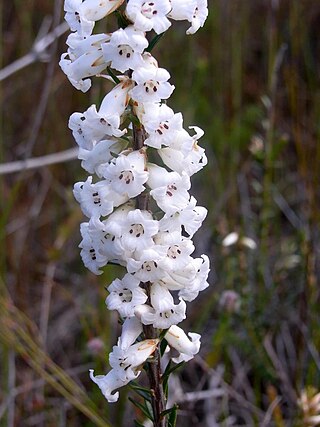
Epacris obtusifolia, commonly known as blunt-leaf heath, is a species of flowering plant from the heath family, Ericaceae, and is endemic to eastern Australia. It is an erect shrub with few stems, crowded, oblong to elliptic leaves and tube-shaped white or cream-coloured flowers arranged along the stems.

Epacris reclinata, commonly known as fuchsia heath, is a species of flowering plant in the family Ericaceae and is endemic to eastern New South Wales. It is a low-lying to spreading shrub with egg-shaped leaves and pink to red, tube-shaped flowers, sometimes with lighter tips.
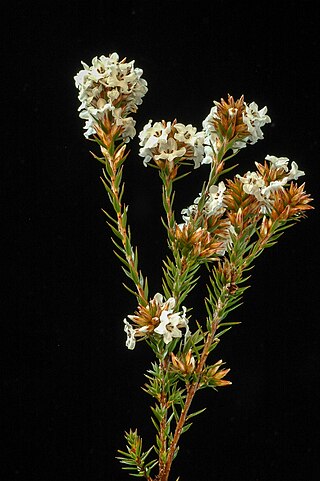
Epacris lanuginosa, commonly known as woolly-style heath, is a species of flowering plant in the family Ericaceae and is endemic to south-eastern Australia. It is a slender, erect shrub with hairy branchlets, linear to lance-shaped leaves, and tube-shaped, white flowers crowded along the ends of the branches.

Commersonia hermanniifolia, commonly known as wrinkled kerrawang, is a species of flowering plant in the family Malvaceae and is endemic to New South Wales. It is a prostrate or trailing shrub with oblong to lance-shaped leaves that are paler on the lower surface, and flowers with five white sepals fading to pink and five pinkish petals.

Lasiopetalum rufum is a species of flowering plant in the family Malvaceae and is endemic to the Sydney region of New South Wales. It is a slender, erect or diffuse shrub with linear leaves and small groups of reddish or pinkish flowers.

Epacris muelleri, commonly known as Mueller's heath, is a species of flowering plant in the heath family Ericaceae and is endemic to eastern New South Wales. It is an erect, or weak straggling shrub with more or less glabrous branchlets, elliptic leaves and white or cream-coloured, tube-shaped flowers.

Leucopogon gracilis is a species of flowering plant in the heath family Ericaceae and is endemic to the south of Western Australia. It is a is a spindly shrub with wiry branchlets, linear to lance-shaped leaves, and dense spikes of white or pinkish flowers.

Epacris gnidioides, commonly known as Budawangs cliff-heath, is a species of flowering plant in the heath family Ericaceae and is endemic to a restricted area of New South Wales. It is a small, creeping shrub with hairy branches, sharply-pointed lance-shaped leaves, and tube-shaped, white flowers.

Epacris crassifolia is a species of flowering plant in the heath family Ericaceae and is endemic to south-eastern New South Wales, Australia. It is a low-lying shrub with elliptic to egg-shaped leaves with the lower end towards the base, and tube-shaped, white or cream-coloured flowers clustered near the ends of the branches.
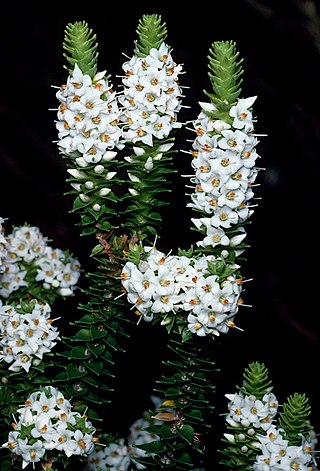
Epacris apiculata is a species of flowering plant in the heath family Ericaceae and is endemic to a small area of New South Wales. It is a small, slender, low-lying to erect shrub with hairy branchlets, egg-shaped leaves with a thickened, pointed tip and tube-shaped flowers with white petals.

Epacris coriacea is a species of flowering plant in the heath family Ericaceae and is endemic to a eastern New South Wales. It is a slender, erect shrub with hairy branchlets, egg-shaped to more or less diamond-shaped leaves and tube-shaped, white or cream-coloured flowers.

Epacris glabella, commonly known as smooth heath, is a species of flowering plant in the heath family, Ericaceae, and is endemic to Tasmania. It is a shrub with erect branches, egg-shaped to elliptic leaves and white, tube-shaped flowers.
Epacris moscaliana, commonly known as seepage heath, is a species of flowering plant in the heath family Ericaceae and is endemic to Tasmania. It is a bushy shrub with wand-like branches, narrowly lance-shaped to egg-shaped or round leaves, and bell-shaped white flowers in clusters at the ends of the branches.

Epacris paludosa, commonly known as swamp heath, is a species of flowering plant from the heath family, Ericaceae, and is endemic to eastern Australia. It is an erect, bushy shrub with lance-shaped, elliptic or egg-shaped leaves and tube-shaped white or cream-coloured flowers in crowded, leafy heads at the ends of branches.

Epacris purpurascens is a species of flowering plant in the heath family Ericaceae and is endemic to eastern New South Wales. It is an erect shrub with egg-shaped or heart-shaped, sharply-pointed leaves and white or pink, tube-shaped flowers.
Epacris rigida is a species of flowering plant in the family Ericaceae and is endemic to eastern New South Wales. It is an erect, bushy shrub with elliptic leaves and white or cream-coloured, tube-shaped flowers.


















